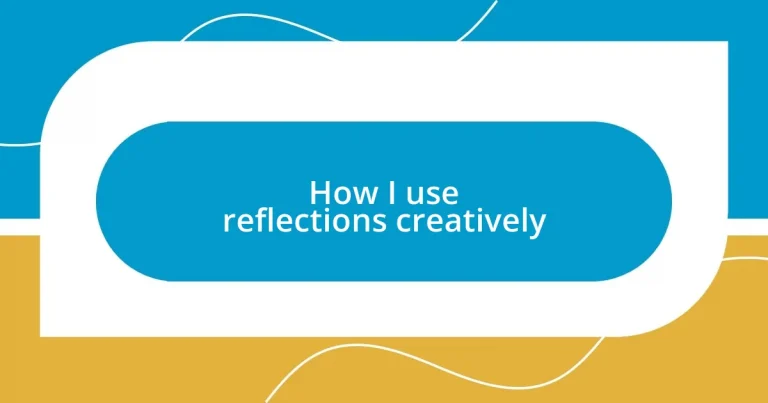Key takeaways:
- Creative reflections allow deeper understanding of emotions and experiences through various artistic expressions such as journaling, painting, and photography.
- Techniques like mind mapping, freewriting, and reflective photography can help unlock insights and process complex feelings nonlinearly.
- Incorporating reflections into art and design can transform experiences into meaningful narratives, enhancing emotional connections with the audience.
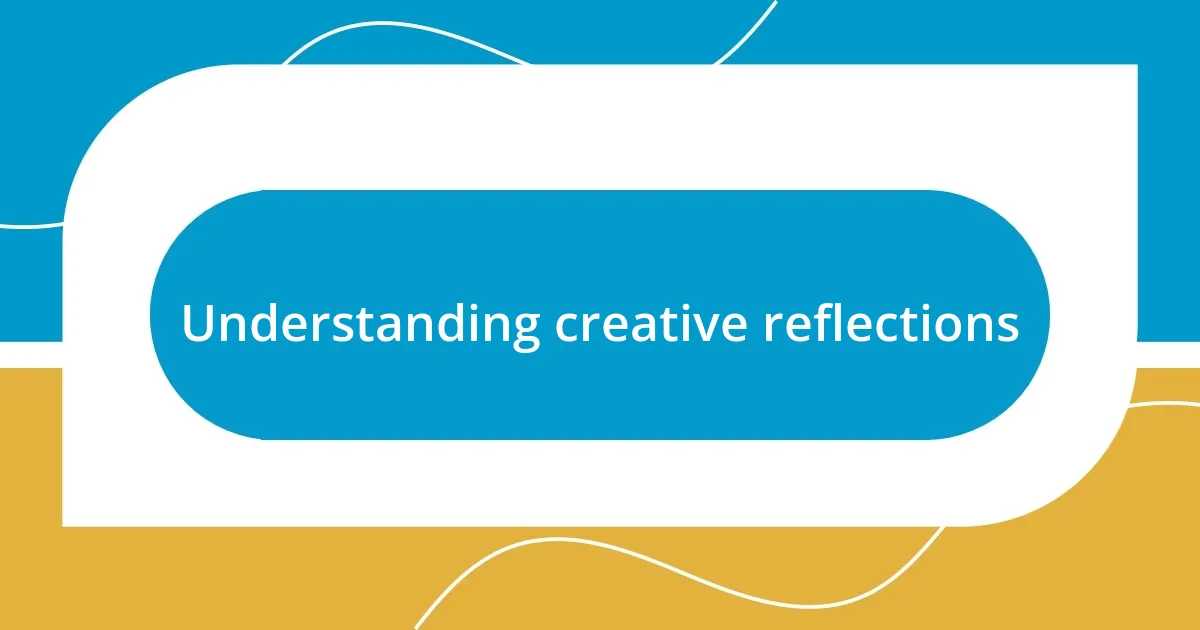
Understanding creative reflections
Creative reflections are deeper expressions of our thoughts and experiences, often allowing us to view our feelings from a fresh perspective. I remember a time when I sketched my emotions instead of writing them down; the colors I chose and the shapes I created helped me understand my feelings in ways words couldn’t. Have you ever experienced a moment where art revealed something about yourself that you didn’t previously recognize?
Engaging in creative reflection provides a pathway to not only process experiences but to transform them into something beautiful and meaningful. For instance, after a particularly challenging project, I started journaling through poetry. Each line helped me unravel the tangled emotions I held inside, turning frustration into inspiration. What if we treated our reflections as a canvas, inviting creativity to guide our understanding of ourselves?
Furthermore, creative reflections serve as a dialogue between our inner world and the external one, fostering a sense of connection to our experiences. I often find solace in creating collages that visually articulate my life’s highs and lows. It’s fascinating how layering images can reflect my journey; each piece crafts a narrative that’s uniquely mine. How can we harness this creativity to not only reflect but also to inspire?

Exploring different reflection techniques
Exploring reflection techniques can open up new avenues for our creativity. One method I enjoy is mind mapping. It’s an approach that visually connects ideas, allowing me to explore my thoughts in a nonlinear way. I remember the first time I used a mind map during a life transition; its structure helped me to see how different experiences intertwined, revealing insights I hadn’t considered.
Another technique I find incredibly useful is freewriting. This involves setting a timer and writing continuously without worrying about grammar or structure. I often do this when I’m feeling overwhelmed or confused. A particularly revealing session led me to discover a recurring theme in my life, shedding light on patterns I hadn’t noticed before. It’s amazing how letting go of conventional writing standards can clarify our thoughts.
Lastly, reflective photography can be a profound technique. It encourages me to capture moments through the lens of my emotions. I recall a day spent at the beach, where snapping pictures of the waves’ movements allowed me to express feelings of tranquility and chaos simultaneously. It’s intriguing how a single image can evoke such a wide range of emotions, merging reflection with creativity in a powerful way.
| Technique | Description |
|---|---|
| Mind Mapping | Visual representation of ideas to explore thoughts nonlinearly. |
| Freewriting | Writing continuously without worrying about format to unlock insights. |
| Reflective Photography | Capturing moments to express and process emotions creatively. |

Incorporating reflections into art
Reflecting on my own experiences, I find incorporating reflections into art can be an enlightening journey. One time, I painted a large canvas using colors that represented my emotional state—deep blues for sadness and vibrant yellows for joy. As I mixed the paint, it was as if I was blending my feelings into a tangible form, allowing me to process complex emotions visually. The layers of color became a solace, each stroke revealing a story about my inner self that I hadn’t fully embraced before.
- One way to incorporate reflections into art is through abstract painting, where colors and shapes embody your emotions.
- Another method is creating visual journals, which combine sketches, colors, and writings to capture thoughts and experiences over time.
- Additionally, I’ve experimented with sculpture, allowing me to mold my feelings into three-dimensional forms that I can touch and interact with, deepening my understanding of my emotional landscape.
As I delve deeper into my art, I realize how impactful these reflections can be. For instance, I recently designed a series of mixed-media pieces that incorporate found objects representing different memories. Each object tells a story—like an old ticket stub reminding me of a cherished adventure—creating a narrative that intertwines my past and present. It’s amazing how transforming reflections into artistic forms can encapsulate feelings that might otherwise remain buried.
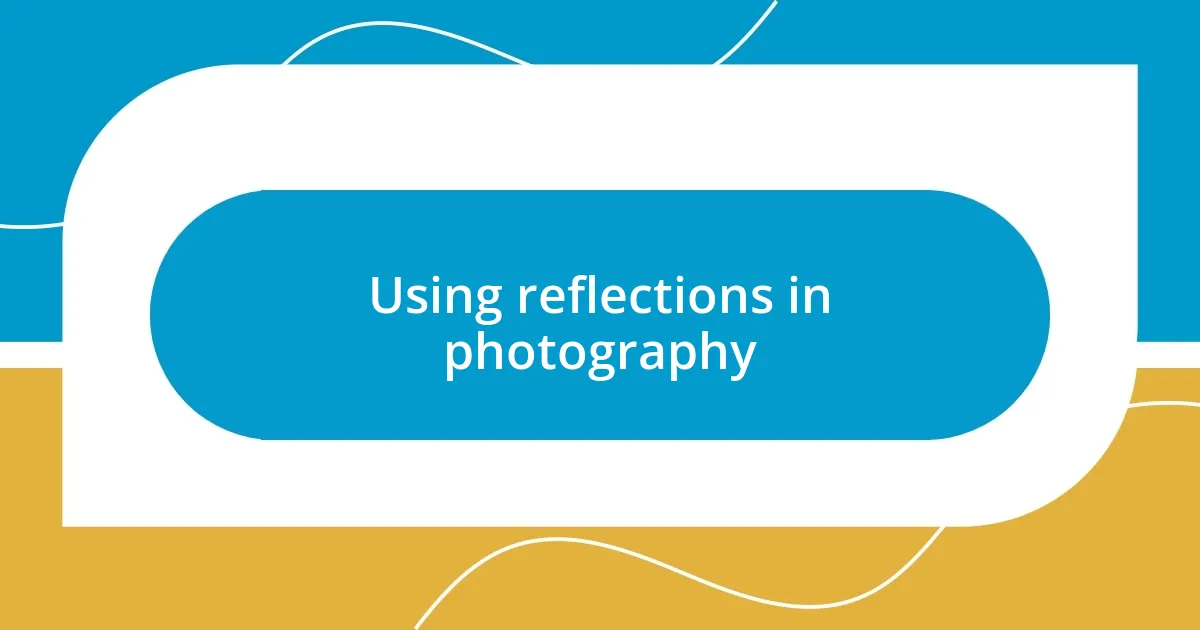
Using reflections in photography
Using reflections in photography can be an incredibly enriching experience. One of my favorite techniques is to capture reflections on water. There was a memorable morning when I visited a serene lake at sunrise. The stillness of the water mirrored the vibrant hues of the sky, creating a surreal scene. I felt a rush of excitement as I positioned my camera, knowing that capturing both the reflection and the original landscape would evoke a sense of harmony and balance in the final image.
Another engaging approach is to find reflections in urban environments. I often wander through city streets after a rain, when puddles create beautiful reflections of buildings and streetlights. It’s fascinating how something ordinary can transform into an extraordinary composition. I once took a photograph of an old brick wall mirrored in a puddle, and the resulting photo felt like a glimpse into history. This technique encourages me to see beauty in everyday moments, challenging my perspective on what surrounds me.
I’ve also experimented with mirrors as props in my photography. I remember trying to create self-portraits where I held a small mirror, pointing it toward an interesting landscape. This method feels like an extension of myself, allowing the viewer to see me in relation to my surroundings. Has anyone else tried this? The interplay of my reflection with the scenery invokes a unique narrative that I find incredibly powerful. Using reflections in this way deepens my connection to the world, revealing layers of emotion and storytelling in each shot.
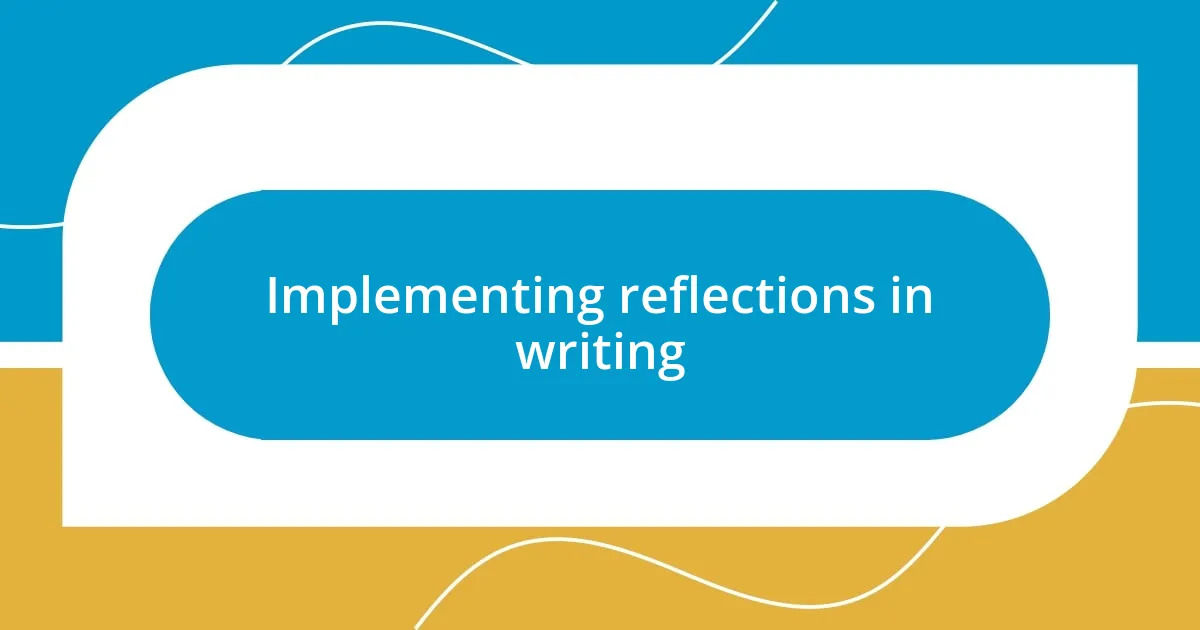
Implementing reflections in writing
Implementing reflections in writing is a transformative process that allows me to delve into my personal experiences. I often start by journaling—pouring out my thoughts on paper and looking for insights within the chaos. There was a time when I grappled with a difficult decision, and as I wrote about it, I unexpectedly discovered reasons behind my emotions that hadn’t been apparent before. Have you ever noticed how writing can clarify your inner struggles?
Using reflections as prompts has also elevated my creative writing. I remember sitting in a café, feeling a wave of nostalgia wash over me as I observed the rain tapping against the window. That atmosphere inspired me to draft a short story centered on lost love, weaving in elements from my own life that felt eerily familiar. By combining these reflections with fiction, I create characters that resonate with my emotions, adding depth to their journeys.
Additionally, I often integrate reflections directly into poetry. One poignant piece I wrote emerged from imagining a conversation with my younger self. As I penned the lines, it became a beautiful exploration of growth and understanding, where I could offer advice and comfort. This practice not only honors my past but also helps me find closure in experiences that shaped who I am today. Do you think reflecting through writing could unlock similar insights for you?

Experimenting with reflections in design
Experimenting with reflections in design opens a world of creativity that truly excites me. I recall a project where I played with reflective surfaces on furniture. By using glass and polished metals, I created playful interactions between light and space, transforming a minimalist room into a vibrant environment. It was that moment when I stepped back and noticed how the reflections not only enhanced the room’s aesthetics but also evoked a sense of movement, making the space feel alive. Have you ever had that experience where an element in your design unexpectedly breathes life into a space?
I also enjoy incorporating reflections in graphic design. The first time I experimented with mirrored effects in typography, I was amazed at how it added depth and intrigue to my work. I designed a poster for a music festival, layering text with subtle reflections that suggested rhythm and dynamism. It sparked an energy that I felt resonated with the event’s vibe. It made me wonder: How can a simple design choice elevate the viewer’s experience?
Lastly, I love to play with digital reflections in my illustrations. One memorable piece I produced involved a landscape that mirrored itself in the water below, creating a symmetrical wonderland. This technique allowed me to convey balance and tranquility, inviting viewers to pause and reflect, literally and figuratively. As I observed their reactions, I thought about how reflections in design can evoke emotions and foster connections. Have you considered how something as simple as a reflection can deepen the narrative within your own designs?
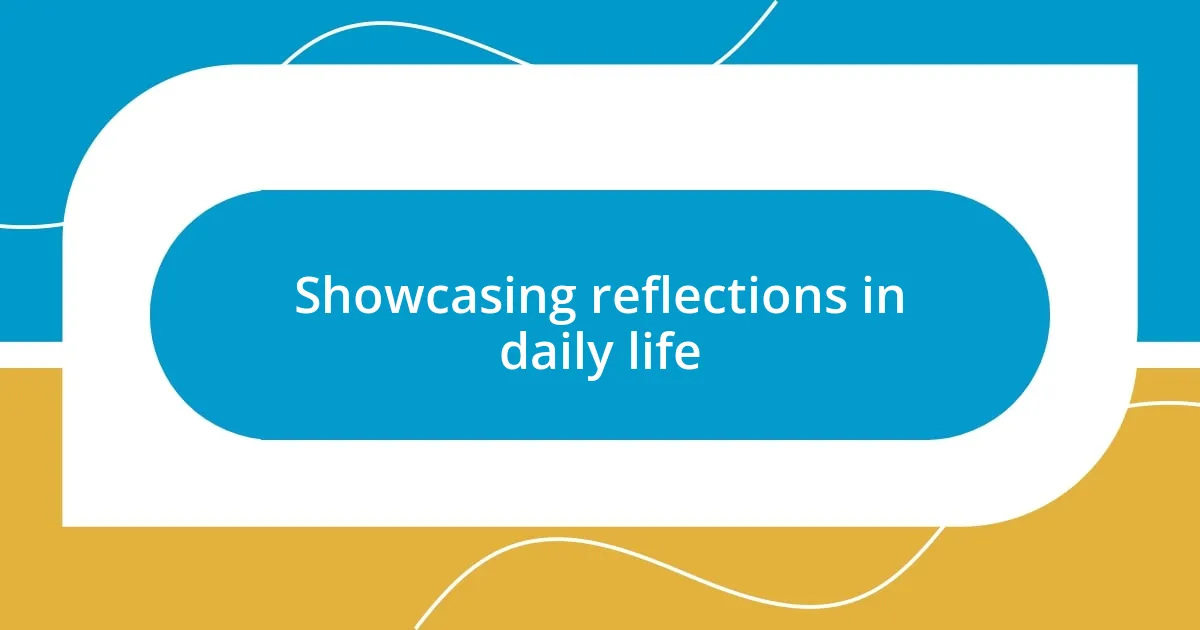
Showcasing reflections in daily life
Showcasing reflections in daily life can be a profound way to engage with our surroundings. I often find myself pausing to admire my reflection in a window during my morning commute. That simple moment, where my face melds with the vibrant cityscape, makes me feel connected to both my inner world and the bustling life around me. Have you ever realized how your reflection can serve as a mirror not just for your appearance, but for your thoughts and feelings in that very instance?
I also incorporate reflective surfaces in home decor as a way of celebrating daily life. One time, I hung a decorative mirror in my living room that not only illuminated the space but also offered a glimpse of my garden’s blossoming flora. It became a conversation starter; guests would often comment on how the mirror added a layer of intrigue, allowing them to see the garden from an angle they hadn’t considered. Doesn’t it feel fulfilling when something as simple as a mirror can transform your interactions with others?
Moreover, my love for photography has led me to explore capturing reflections in nature. During a hike last summer, I stumbled upon a serene lake reflecting a breathtaking sunset. I seized the moment and snapped a photo, which later became a favorite among my friends. This experience reminded me how reflections can capture fleeting beauty, turning ordinary moments into timeless memories that we can cherish. Have you ever experienced the magic of noticing reflections that tell a story in your own life?












